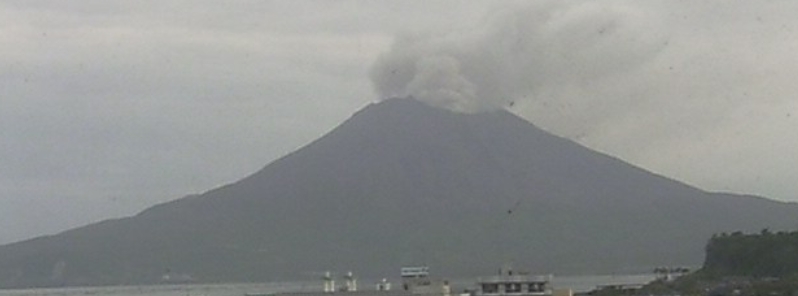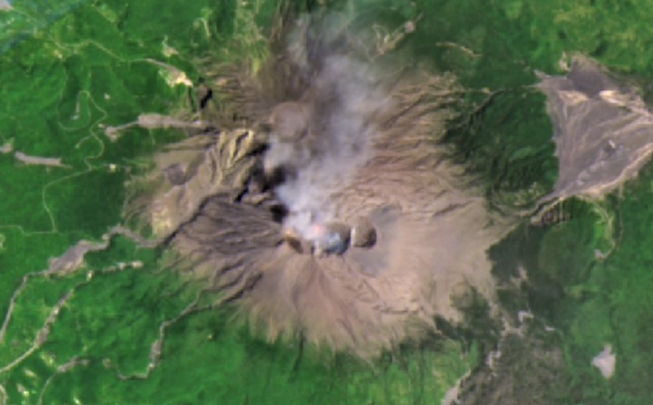Strong eruptions at Sakurajima volcano, Japan

Strong eruptions continue at Minamidake crater of Sakurajima volcano in Japan since April 27, 2020. A Level 3 near-crater warning is in effect in the area since 2016.
A strong explosion at 13:46 UTC (22:52 LT) on April 27 generated an ash plume that rose over 3 km (9 843 feet) above the crater rim and ejected blocks some 600 to 900 m (1 969 to 2 953 feet) from the top of the volcano.
Incandescence has been visible at night since then.
April 27, 2020, ~ Volcanic Lightning ~ Sakurajima Volcano, Japan #volcano #sakurajima #japan
22:46 JST pic.twitter.com/Rwu7zkrpgg— Volcano Time-Lapse (@DavidHe11952876) April 27, 2020
At 21:00 UTC on May 1 (06:00 LT on May 2), JMA reported a powerful eruption as explosive activity continued from the active crater.
The dense dark ash plume reached around 2 743 m (9 000 feet) a.s.l., dispersing northward. Blocks were emitted as far as 900 m (2 952 feet) away.

Image credit: USGS/Landsat-8, Antonio Vecoli.
At 22:04 UTC on May 7 (07:04 LT on May 8), the volcano spewed a dense, dark ash plume up to 2 000 m (6 561 feet) above the summit.
The following day, at 20:32 UTC on May 8 (05:32 LT on May 9) it ejected ash plumes up to 4 200 m (13 780 feet) a.s.l. Blocks were ejected as far as 1 000 m (3 280 feet) away.
Sakurajima erupted again this morning with plume 4200m pic.twitter.com/e4A8JcSKpg
— VolcanoYT (@VolcanoYTz) May 8, 2020
Volcano Sakurajima Eruption with height plume 2000m at 08/05/2020 07:03 JST time pic.twitter.com/yJVzCRbosY
— VolcanoYT (@VolcanoYTz) May 7, 2020
El activo #Sakurajima causó una explosión esta madrugada en #Japón que expulsó material a 4.4 km sobre el cráter junto a incandescencia en la cumbre.
Este es el estado actual en el amanecer del país asiático, con emisiones a baja altura y débiles en explosividad. pic.twitter.com/mvRwPcPRLP
— EarthQuakesTime (@EarthQuakesTime) May 8, 2020
Sakurajima Volcano Japan, 08.05.2020, 06:50 local time
visit Volcanoverse: https://t.co/BdTovohbvE pic.twitter.com/GN8qCyy1WJ— Rita Bauer (@wischweg) May 8, 2020
Yet another eruption was reported at 12:11 UTC (21:11 LT) on May 11. Ash was ejected around 2 450 m (8 000 feet) a.s.l., drifting northeast.
The volcano emits about 2 300 tonnes of sulfur dioxide per day, JMA said.
A Level-3 near-crater warning is in effect since February 5, 2016. Residents and tourists are urged to refrain from entering the danger zone.
midnight eruption of sakurajima pic.twitter.com/mDC5FKcwc1
— VolcanoYT (@VolcanoYTz) May 11, 2020
Geological summary
The Aira caldera in the northern half of Kagoshima Bay contains the post-caldera Sakurajima volcano, one of Japan's most active. Eruption of the voluminous Ito pyroclastic flow accompanied formation of the 17 x 23 km (10.5 x 14.3 miles) caldera about 22 000 years ago. The smaller Wakamiko caldera was formed during the early Holocene in the NE corner of the Aira caldera, along with several post-caldera cones.
The construction of Sakurajima began about 13 000 years ago on the southern rim of Aira caldera and built an island that was finally joined to the Osumi Peninsula during the major explosive and effusive eruption of 1914. Activity at the Kitadake summit cone ended about 4 850 years ago, after which eruptions took place at Minamidake.
Frequent historical eruptions, recorded since the 8th century, have deposited ash on Kagoshima, one of Kyushu's largest cities, located across Kagoshima Bay only 8 km (5 miles) from the summit. The largest historical eruption took place during 1471-76. (GVP)
Featured image credit: EarthQuakes Time/Twitter

Commenting rules and guidelines
We value the thoughts and opinions of our readers and welcome healthy discussions on our website. In order to maintain a respectful and positive community, we ask that all commenters follow these rules:
We reserve the right to remove any comments that violate these rules. By commenting on our website, you agree to abide by these guidelines. Thank you for helping to create a positive and welcoming environment for all.